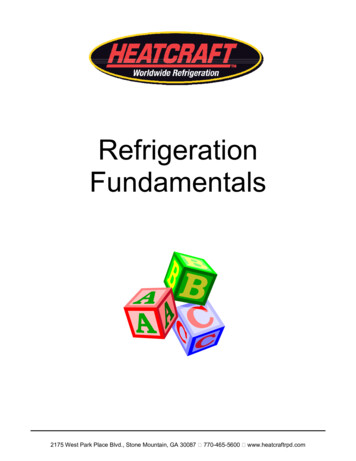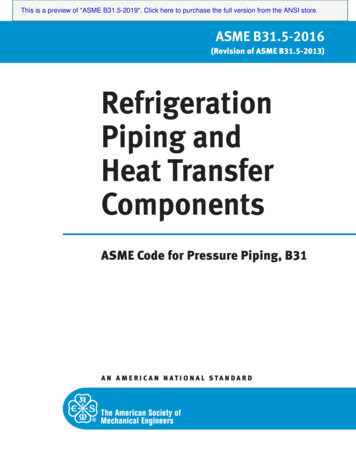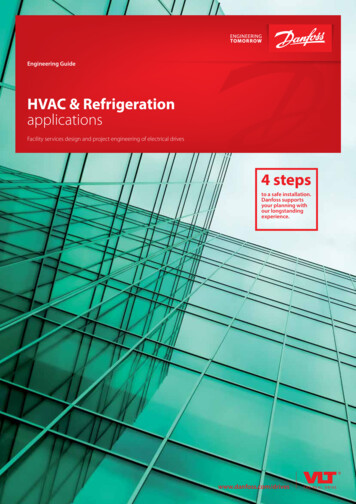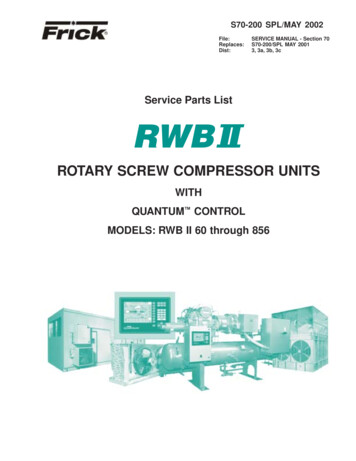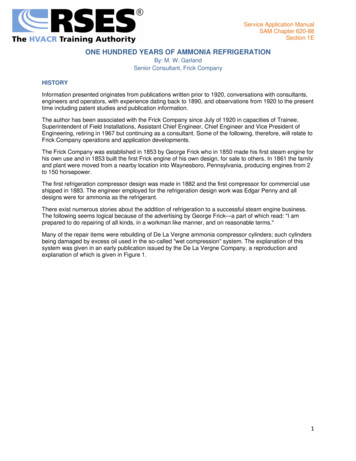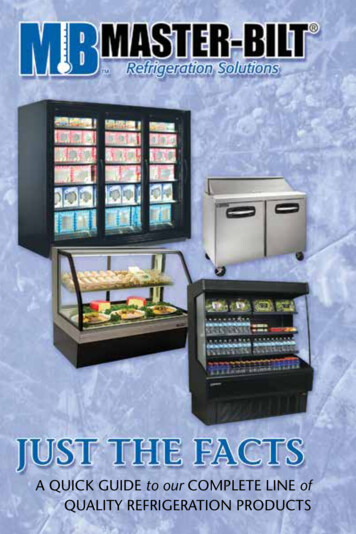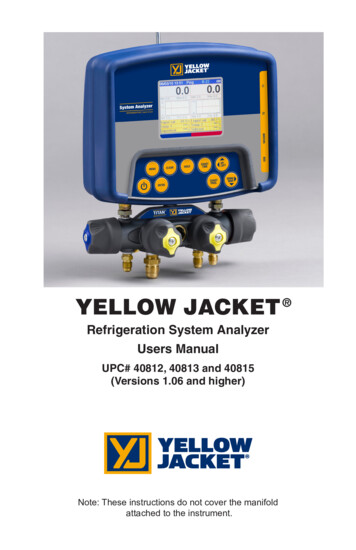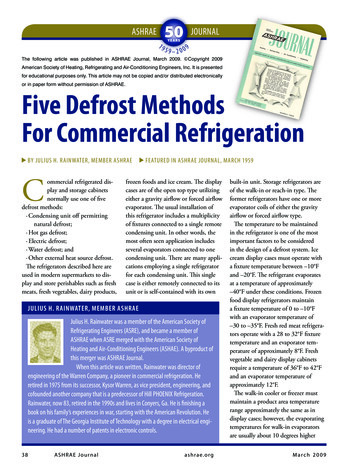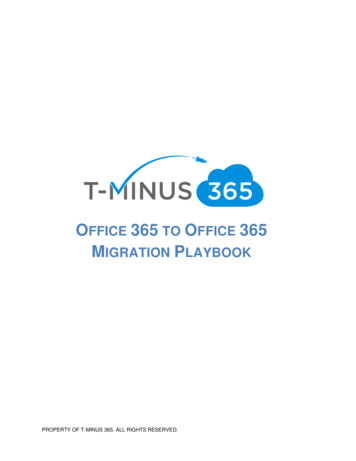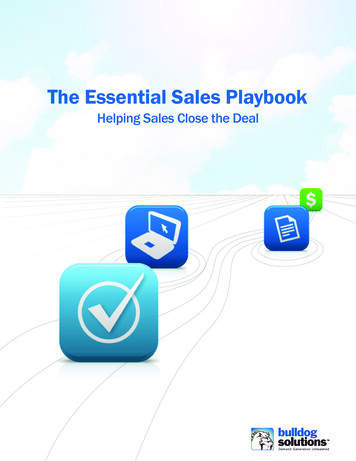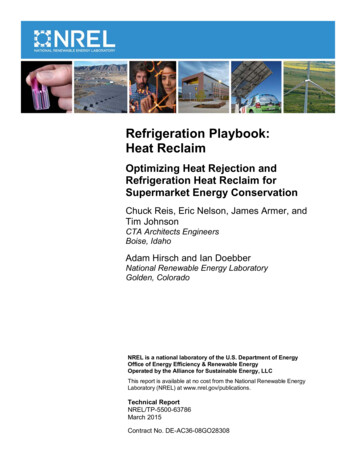
Transcription
Refrigeration Playbook:Heat ReclaimOptimizing Heat Rejection andRefrigeration Heat Reclaim forSupermarket Energy ConservationChuck Reis, Eric Nelson, James Armer, andTim JohnsonCTA Architects EngineersBoise, IdahoAdam Hirsch and Ian DoebberNational Renewable Energy LaboratoryGolden, ColoradoNREL is a national laboratory of the U.S. Department of EnergyOffice of Energy Efficiency & Renewable EnergyOperated by the Alliance for Sustainable Energy, LLCThis report is available at no cost from the National Renewable EnergyLaboratory (NREL) at www.nrel.gov/publications.Technical ReportNREL/TP-5500-63786March 2015Contract No. DE-AC36-08GO28308
Refrigeration Playbook:Heat ReclaimOptimizing Heat Rejection andRefrigeration Heat Reclaim forSupermarket Energy ConservationChuck Reis, Eric Nelson, James Armer, andTim JohnsonCTA Architects EngineersBoise, IdahoAdam Hirsch and Ian DoebberNational Renewable Energy LaboratoryGolden, ColoradoPrepared under Task No. ARCB1102Prepared under Subcontract No. LEA-0-40383-01NREL is a national laboratory of the U.S. Department of EnergyOffice of Energy Efficiency & Renewable EnergyOperated by the Alliance for Sustainable Energy, LLCThis report is available at no cost from the National Renewable EnergyLaboratory (NREL) at www.nrel.gov/publications.National Renewable Energy Laboratory15013 Denver West ParkwayGolden, CO 80401303-275-3000 www.nrel.govTechnical ReportNREL/TP-5500-63786March 2015Contract No. DE-AC36-08GO28308
NOTICEThis report was prepared as an account of work sponsored by an agency of the United States government.Neither the United States government nor any agency thereof, nor any of their employees, makes any warranty,express or implied, or assumes any legal liability or responsibility for the accuracy, completeness, or usefulness ofany information, apparatus, product, or process disclosed, or represents that its use would not infringe privatelyowned rights. Reference herein to any specific commercial product, process, or service by trade name,trademark, manufacturer, or otherwise does not necessarily constitute or imply its endorsement, recommendation,or favoring by the United States government or any agency thereof. The views and opinions of authorsexpressed herein do not necessarily state or reflect those of the United States government or any agency thereof.This report is available at no cost from the National Renewable EnergyLaboratory (NREL) at www.nrel.gov/publications.Available electronically at http://www.osti.gov/scitechAvailable for a processing fee to U.S. Department of Energyand its contractors, in paper, from:U.S. Department of EnergyOffice of Scientific and Technical InformationP.O. Box 62Oak Ridge, TN 37831-0062phone: 865.576.8401fax: 865.576.5728email: mailto:reports@adonis.osti.govAvailable for sale to the public, in paper, from:U.S. Department of CommerceNational Technical Information Service5285 Port Royal RoadSpringfield, VA 22161phone: 800.553.6847fax: 703.605.6900email: orders@ntis.fedworld.govonline ordering: http://www.ntis.gov/help/ordermethods.aspxCover Photos: (left to right) photo by Pat Corkery, NREL 16416, photo from SunEdison, NREL 17423, photo by Pat Corkery, NREL16560, photo by Dennis Schroeder, NREL 17613, photo by Dean Armstrong, NREL 17436, photo by Pat Corkery, NREL 17721.NREL prints on paper that contains recycled content.
AcknowledgmentsRefrigeration Playbook: Heat Reclaim was developed as a joint effort between the NationalRenewable Energy Laboratory and CTA Architects Engineers. This project was made possiblewith American Recovery and Reinvestment Act of 2009 funds.The authors would like to thank Arah Schuur and Glenn Schatz of the U.S. Department ofEnergy Building Technologies Office for their support and guidance and to acknowledgereviewers who provided helpful feedback during the development of the playbook, includingRen Anderson, Eigen Energy; Ryon Browning, CLEAResult; Harrison Horning, Delhaize; RonJudkoff, National Renewable Energy Laboratory; K.C. Kolstad and Mike Saunders, EmersonClimate Technologies; Tom Land, U.S. Environmental Protection Agency; Dustin Lilya, DCEngineering; Dustin Searcy, Parker Hannefin Corporation; and Caleb Nelson, CTA ArchitectsEngineers.iiiThis report is available at no cost from the National Renewable Energy Laboratory (NREL) at www.nrel.gov/publications.
Abbreviations and AcronymsASHRAEAmerican Society of Heating, Refrigerating and Air-ConditioningEngineersANSIAmerican National Standards InstituteBtuBritish thermal unitCBPCommercial Building PartnershipsCFMcubic feet per minutedbdry bulbDOEU.S. Department of EnergyDSHdesuperheatεeffectiveness or efficiency valueEERenergy efficiency ratio - Btu/W-hEIRenergy input ratioEWTentering water temperatureGPMgallons per minuteHVACheating, ventilation, and air-conditioningin.inchIPImperial unitskWkilowattLATleaving air temperatureLWTleaving water temperatureMATmixed air temperatureNRELNational Energy Renewable LaboratoryOAToutdoor air temperaturep-hpressure-enthalpyPLRpart-load ratioivThis report is available at no cost from the National Renewable Energy Laboratory (NREL) at www.nrel.gov/publications.
ppmpart per millionSIInternational System of Units, also referred to as metric unitsSHWservice hot waterTHRtotal heat of rejectionTABtest adjust and balanceTCtechnical committeeTDtemperature differentialUthermal transmittance - Btu/h ft2 FUPSuninterruptible power supplyUSGBCU. S. Green Building CouncilWWattswbwet bulbWSHPwater-source heat pumpvThis report is available at no cost from the National Renewable Energy Laboratory (NREL) at www.nrel.gov/publications.
Executive SummaryBackgroundThis refrigeration playbook for optimizing heat rejection and refrigeration heat reclaim forsupermarket energy conservation emerged from work done as part of the U.S. Department ofEnergy’s Commercial Building Partnerships (CBP) program. CBP was a public/private, costshared initiative that demonstrated cost-effective, replicable ways to achieve dramatic energysavings in commercial buildings. It aimed to reduce energy use by 50% in new construction and30% in existing buildings compared with minimum code requirements or with pre-retrofit energyuse. Building owners teamed with the U.S. Department of Energy, national laboratory staff, andprivate sector experts to explore and implement energy-saving ideas and strategies. Thesestrategies were then applied to specific building projects that could be replicated across anorganization’s building portfolio and eventually across the commercial building market.Much of the analysis presented here emerged from a CBP pilot retrofit of a 213,000-ft2 Walmartsupercenter in Colorado in which waste heat reclaim was used to heat ventilation air for thegrocery sales area. It saves almost 20,000 therms of natural gas per year. While the resultssupport Walmart’s 20% energy savings commitment under the Better Buildings Challenge, theyare also applicable to the whole supermarket sector. This includes companies with commercialrefrigeration, such as Target, Whole Foods Market, SUPERVALU, and the Defense CommissaryAgency, that also participated in CBP.While heat reclaim systems have been used in supermarkets for many years, their performance isnot well understood. At the same time, recent legislation in some parts of the country, includingCalifornia and Washington, requires refrigeration waste heat to be recovered in supermarketsthat meet certain criteria. This makes the calculation of energy savings from heat reclaimstrategies critical to many store designs. This guide attempts to demystify the energy savingsassociated with heat reclaim strategies by providing information and tools to help experiencedrefrigeration system designers make informed decisions that add value to a building design byreducing operating and life cycle costs.PurposeThe purpose of this playbook and accompanying spreadsheets is to generalize the detailed CBPanalysis and to put tools in the hands of experienced refrigeration designers to evaluate multipleapplications of refrigeration waste heat reclaim across the United States. Supermarkets with largeportfolios of similar buildings can use these tools to assess the impact of large-scaleimplementation of heat reclaim systems. In addition, the playbook provides best practices forimplementing heat reclaim systems to achieve the best long-term performance possible. Itincludes guidance on operations and maintenance as well as measurement and verification.ScopeThis playbook was written with a traditional supermarket of 40,000–60,000 ft2 in mind, but theconcepts apply to smaller and larger facilities with commercial refrigeration systems. Theconcepts and methods do not provide a complete design or precise calculations for determiningthe energy savings associated with managing heat rejection. Long-term savings will also dependon weather variability and the degree to which systems are properly maintained. Rather, theyviThis report is available at no cost from the National Renewable Energy Laboratory (NREL) at www.nrel.gov/publications.
provide ideas and tools to assist in the design process through building operations to achievelong-term savings. When considering other applications, such as convenience stores andindustrial refrigeration, care should be taken to determine which parameters should be adjustedto match the application. Brief chapter summaries follow. Chapter 1 covers the goals and scope of the playbook in more detail and describes theapproach to energy analysis. Chapter 2 provides guidance for minimizing refrigeration waste heat before discussinghow to reclaim it; this is a necessary first step that will save more energy than reclaimingheat from a wasteful system. Chapter 3 describes different applications of refrigeration waste heat reclaim, includingservice hot water preheating, mixed air heating, and outdoor air preheating; it alsodiscusses desuperheating versus full condensing and different methods for capturing anddelivering the heat. System diagrams accompany each application. Chapter 4 is a step-by-step tour through the thermodynamic calculations needed toevaluate each heat reclaim application, including the waste heat available and the demandfor that heat, that are built into the spreadsheets that accompany the playbook. Chapter 5 includes best practices for implementing heat reclaim methods, including anintroduction to financial analysis techniques, operations and maintenance, andmeasurement and verification, that are needed to estimate an expected return oninvestment of a heat reclaim system and then ensure good long-term performance. Appendix A tabulates results from the baseline supermarket energy model and energysavings provided by different waste heat reclaim strategies in 17 locations spanning U.S.climate types. The results also include the impacts of air-cooled, evaporatively cooled,and hybrid condensing strategies. Appendix B includes best practices for accurately modeling commercial refrigerationsystems in EnergyPlus. Appendix C provides all the details of the EnergyPlus baseline supermarket used tobenchmark whole-building energy use.Each chapter provides resources for further study and discussion.MethodsThe playbook and worksheets rely on simple thermodynamic relationships to determine theamount of heat available for reclaim, the demand for that waste heat by different building enduses, and the resulting potential energy savings of different waste heat reclaim applicationsacross U.S. climate zones.EnergyPlus was used to model the whole-building energy use of a reference supermarket thatcorresponds as closely as possible to the assumptions of the playbook and spreadsheets;however, it was not used to calculate the heat reclaim savings because of current limitations inmodeling superheat and refrigerant mass flow. For now, the EnergyPlus results should beconsidered as a broad-brush picture of the variability that can be expected in whole-buildingviiThis report is available at no cost from the National Renewable Energy Laboratory (NREL) at www.nrel.gov/publications.
energy consumption across climate zones. Differences in the way the refrigeration evaporatorload was modeled between EnergyPlus and the spreadsheet models prevent a direct apples-toapples comparison. In the long run, EnergyPlus is expected to be the preferred approach toestimating waste heat reclaim savings because it accounts for the dynamic interaction betweenthe refrigeration system and the rest of the store and allows representation of heat pump-basedsystems that could not be captured with the spreadsheet calculations.ConclusionsFrom the results and the authors’ experience, domestic hot water seems to be the simplest andmost cost-effective method of heat reclaim and is the most broadly deployed heat reclaimstrategy today. The service hot water load in a supermarket is fairly consistent throughout theyear. These systems can work in any climate zone. Outdoor air preheat can be a good solution incolder climates, especially in 100% outdoor air systems. A heat reclaim system for space heatingcan result in the most energy savings of the methods discussed, but also can be the most difficultto implement because it requires placing a large heating coil in the primary airstream and isdifficult to implement in retrofits.The playbook is intended for use in conjunction with the accompanying spreadsheet models. Itincludes descriptions of heat reclaim systems, considerations for implementing each method, andthe thermodynamic theory behind the spreadsheet models. The spreadsheets are provided so thatan experienced designer can quickly generate energy performance results for each heat reclaimmethod and optimize the recovery of waste heat for use in building heating, ventilation, and airconditioning and service hot water systems.Before a heat reclaim strategy is implemented on a large scale, the authors recommend testingthe technology and measuring its
Chuck Reis, Eric Nelson, James Armer, and Tim Johnson . CTA Architects Engineers Boise, Idaho . Adam Hirsch and Ian Doebber . National Renewable Energy Laboratory Golden, Colorado . Prepared under Task No. ARCB1102 Prepared under Subcontract No. LEA-0-40383-01 . Technical Report. NREL/TP-5500 -63786 . March 2015 . NOTICE. This report was prepared as an account of work
